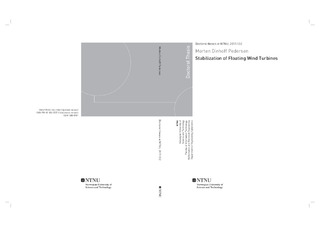Stabilization of Floating Wind Turbines
Doctoral thesis
Permanent lenke
http://hdl.handle.net/11250/2450500Utgivelsesdato
2017Metadata
Vis full innførselSamlinger
Sammendrag
Wind turbines mounted on floating platforms are, under a specific set of circumstances,
prone to a phenomena called control-induced resonance. The phenomena
materializes as persistent oscillations in the platform’s surge and pitch
displacement and occurs when pitch-control algorithms without modifications
for floating operation are used.
This thesis examines the physical underpinnings of the resonance problem by a
novel modeling strategy. A systems approach is adopted where the floating wind
turbine is conceived as an interconnection of subsystems. New aerodynamic
models suitable for a systems approach are proposed, validated and examined.
Notably, a vortex theoretical approach is shown to be fruitful both in the steady
and unsteady loading regimes. A new type of dynamic inflow model based on
vortex transport and frequency domain identification is proposed and compared
favorably to existing strategies. The vortex lifting law is used to generate a
succinct model for loads that fits into the systems representation and replaces
the commonly used table-data approach. A simplified dynamic model suitable
for control analysis is derived and validated against a standard tool in windturbine
analysis.
The system model developed in the first part of the thesis is used for a smallsignal
stability analysis invoking passivity tools in the second part. It is shown
that floating wind turbines are stable under quite general conditions as long
as no pitch control is applied. If collective blade pitch is used for the sole
purpose of setpoint control of the angular velocity, destabilization is shown to
be inevitable. An examination of the energy flow within the wind turbine system
motivates a novel "energy shaping" control strategy. Existing control strategies
are also examined in the new paradigm. A case study of a representative 5MW
wind turbine is performed. The resonance phenomena is demonstrated under
realistic conditions. A number of control strategies are tested and compared.
The "energy shaping" control strategy is shown to perform well and eliminates
the control-induced resonance. Justification for the results are given based on
the theory developed in the thesis.
